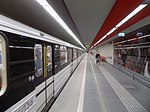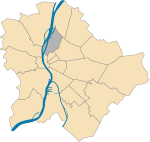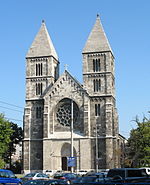Dózsa György Street Synagogue
13th District of BudapestFormer synagogues in HungaryLipót Baumhorn buildingsSynagogues completed in 1909Synagogues in Budapest

The Dózsa György Street Synagogue Budapest XIII. district synagogue. Originally used as a synagogue, the building is now used by the Budapest Honved Fencing Hall, and the religious building continues in a smaller building formerly used as a cultural hall under the religious guidance of Rabbi Peter Deutsch.
Excerpt from the Wikipedia article Dózsa György Street Synagogue (License: CC BY-SA 3.0, Authors, Images).Dózsa György Street Synagogue
Dózsa György út, Budapest Angyalföld
Geographical coordinates (GPS) Address Website External links Nearby Places Show on map
Geographical coordinates (GPS)
| Latitude | Longitude |
|---|---|
| N 47.52239 ° | E 19.06732 ° |
Address
Dózsa György úti zsinagóga
Dózsa György út 55
1134 Budapest, Angyalföld
Hungary
Open on Google Maps









